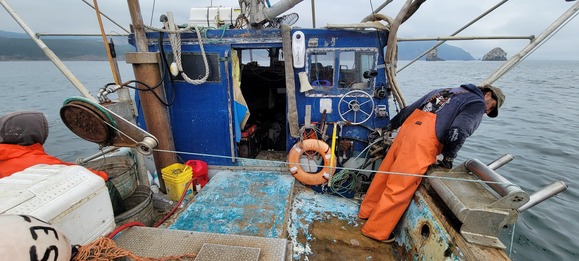Oregon Human Dimensions Monitoring Featured in British Columbia's Best Practices Guide
Photo: Nature United released a best practices guide for Marine Protected Area Network Monitoring and included Oregon examples for Human Dimensions.
Our human dimensions program was recognized as a global leader in human dimensions monitoring in a recent publication by Nature United, Canada.
The publication summarizes global insights on best practices and procedures for Marine Protected Area (MPA) network monitoring. It informs British Columbia’s planning efforts in the Northern Shelf Bioregion – a priority location for a new MPA network. The publication includes a case study of the Oregon Human Dimensions Program research over the last decade, written by former Marine Reserve Program Leader Cristen Don.
Marine Reserves Program staff previously shared lessons learned from the Oregon experience with Canadian colleagues during two expert workshops, which led to a request for an Oregon case study. Former Marine Reserve Program Leader Cristen Don stepped in to author the case study to meet the tight deadline.
These efforts led to the inclusion of Oregon examples throughout the publication such as lesson learned from early stages of MPA formation and monitoring design, baseline monitoring, monitoring indicators, indicator selection process, data collection, and communications and reporting.
Click below to explore the top six Oregon contributions mentioned throughout the report.

 Photo: Captain Wilson Thompson hauls in longline gear during a survey at the Redfish Rocks Marine Reserve.
Return to Redfish Rocks for a Longtime Port Orford Commercial Fisherman
A seasoned commercial fisherman, Wilson Thompson is one of the last in Port Orford who fished Redfish Rocks before it became a marine reserve.
But he was back in the reserve this fall for the first time in over a decade with a new purpose: captaining the marine reserves’ Ecological Team to conduct longline and hook-and-line surveys.
Captain Thompson was eager to see for himself what’s been going on in Redfish Rocks – after all, he attended public meetings held before the area become a reserve and he could no longer fish there.
“Captaining the Ecological Team out to my old fishing grounds was a chance for me to see in person how the team works, what they do, and what’s been going on here,” Thompson said. “And the practical side of me signed on to help because there was no one else to do it.”
Our ecological team is glad he did. The team depends on collaborations with fishermen like Captain Thompson to conduct fishing surveys in all five marine reserves and comparison areas. Click below for more reflections from Captain Thompson on returning to the Redfish Rocks Marine Reserve.

 Photo: Our human dimensions research team handed out questionaires to Oregon Coast visitors this summer.
Human Dimensions Highlights
 |
|
Researchers at Utah State and Oregon State Universities are collaborating with our program to study the non-market economic values of marine reserves. The team sent an online survey to 900 Oregonians, representative of the state's residents in terms of gender, race/ethnicity, age, household income, and education. The survey aims to assess public knowledge and attitudes towards marine reserve management and understand how Oregonians think about intentional marine ecosystem-based responses to climate change (e.g., restoring tidal marsh habitat to store carbon). Stay tuned for research results this winter. |
 |
|
Working with collaborators at Oregon State University to study marine reserve knowledge and awareness in Oregon coast visitors, our research team completed surveys at 23 sites from Cannon Beach to Port Orford, completing 2,451 questionnaires during the summer. Respondents came from 49 different states and 19 different countries; 49% of whom were from Oregon. Our sample size makes this the largest visitor intercept survey conducted by the Oregon Marine Reserves team. This research also contributes to our understanding of how the ocean acts as a reminder for climate change, and how to communicate ocean changes to inspire personal climate action among visitors to the coast. |
 |
|
A project is currently underway with The Research Group, LLC to update our nearshore fisheries spatial economic model that is used to assess the potential impacts to nearshore fisheries that may occur due to any nearshore spatial policy decision, such as marine reserve closures. The model relies on benthic habitat data, species habitat relationships and nearshore fishery data to predict fishing industry economic contributions in the nearshore and predict the potential impact from management closures. Work completed over the last several months includes updating the nearshore fishery data inputs to include the years of 2020 and 2021 for commercial, recreational and distant water fisheries. Pending work includes ground truthing the updated spatial model by comparing the model estimates with the most recent fishery log-book data. |
 Photo: The ecological team completed six different types of monitoring activities over the summer and fall.
Updates From the Field
 |
|
Cape Falcon, Redfish Rocks Our team completed fall hook-and-line (HnL) surveys out of Garibaldi in September, wrapping up the 2023 season at the Cape Falcon Marine Reserve. The four days of sampling could not have been completed without all 37 dedicated volunteers who fished with us. Thank you to captain Lance on the F/V Norwester who helped us conduct these surveys. We also completed six days of fall HnL surveys at the Redfish Rocks Marine Reserve and comparison areas with the help of the F/V Fantasy. |
 |
|
Redfish Rocks For the first time since 2019, six days of longline surveys were completed at the Redfish Rocks Marine Reserve and comparison areas. Thank you to Captain Wilson on the F/V Fantasy who helped us conduct these surveys. |
 |
|
Otter Rock Fall SCUBA surveys at the Otter Rock Marine Reserve and its comparison area have wrapped up for the season. With the help of volunteer divers and the Oregon Coast Aquarium, 60 transects were completed targeting invertebrate, algae, and benthic communities. |
 |
|
Cape Falcon, Cascade Head, Otter Rock, Cape Perpetua, Redfish Rocks Oceanographic moorings and sensors at four marine reserves (Cape Falcon, Cascade Head, Otter Rock and Redfish Rocks) were retrieved for the season. Thanks to the following vessels and partners who helped with these efforts: F/V Lady Lee, F/V Fantasy, F/V My Lee, R/V Elakha, R/V Gracie Lynn, and multiple collaborators at Oregon State University. The moorings collect temperature and oxygen data from spring to fall and help us uncover how stressful ocean conditions were during this time (e.g. marine heatwaves and periods of low oxygen). Our OSU collaborators are currently working to retrieve the mooring at Cape Perpetua. |
 |
|
Otter Rock, Redfish Rocks The Standard Monitoring Units for Recruitment of Fishes (SMURFS) were sampled bi-weekly from July- mid September at both Redfish Rocks and Otter Rock sites. Our collaborators at Oregon State University report 1,824 fish were collected. The SMURFs were retrieved mid-September for the season. |
 |
|
Cascade Head, Otter Rock, Cape Perpetua It was a busy summer of collaborative work in the intertidal. We partnered with UC Santa Cruz and the Multi-Agency-Rocky-Intertidal-Network (MARINe) to complete biodiversity surveys at our three marine reserves. We also worked with partners at Oregon State University to survey the sea star health and mussel bed communities. Like last year, less than 1 % of sea stars showed signs of sea star wasting disease. Thank you to all 18 volunteers who helped us with these early morning surveys. |
New Staff Updates
Photo: Dr. Sarah Klain is our new Human Dimensions Project Leader.
Announcing Our New Human Dimensions Project Leader
Dr. Sarah Klain
We are pleased to announce a new Human-Dimensions Project Leader – Dr. Sarah Klain.
Sarah brings a wealth of human dimensions research experience to our team, including working with fishermen on the Oregon coast to help inform the process for creating the reserves as well as a current project exploring non-market economic values of the marine reserves. She has worked with indigenous knowledge managing marine ecosystems in Micronesia and studied social and cultural values to inform marine spatial planning in British Columbia. Her PhD research focused on risk and benefit perception of offshore wind on the East Coast as well as community engagement on island communities near proposed wind projects. Prior to joining our team, she taught ecological economics and environmental policy at Utah State University. Her favorite hobbies are trail running with her golden doodles, playing at the beach with her kids and attending her husband's bluegrass concerts. Sarah will join our team starting in mid-January 2024.
Welcome to Sea Grant Natural Resource Policy Fellow
Sam Cheplick
Photo: Sam Cheplick is our new Sea Grant Natural Resource Policy Fellow.
Sam joined the ODFW Marine Reserves Program in November as a Sea Grant Natural Resource Policy Fellow with a specific interest in the socioeconomic research of Oregon’s marine reserves. He will be boosting our program's capacity in economic research and working with Sarah to update our human dimensions monitoring plan. In 2022, Sam worked with Washington Sea Grant (WSG) as the Socioeconomic Environmental Outreach Coordinator. At WSG, he supported shellfish farms in mitigating the socioeconomic impacts of harmful algal blooms (HABs) through the SoundToxins program. He completed his master’s degree from Clemson University where his thesis focused on the underlying factors limiting the overall production of fish and shellfish products through mariculture in South Carolina. His work combined novel research in grow-out methods and market evaluation for Southeastern shellfish mariculture production.
Farewell to Emmah Johannes and Mark Freeman
Photo: Two temporary six-month staff members departed our program this fall, Emmah Johannes and Mark Freeman.
The fall was a time of change for our program, marked by the departure of two talented temporary staff members - Emmah Johannes and Mark Freeman.
Emmah was our six-month research assistant supporting our hook and line, longline, intertidal and juvenile fish (SMURF) surveys. Her positive nature, skill and enthusiasm for fieldwork will be missed by staff, volunteers and captains alike.
Mark was our six-month public affairs specialist, leading our program's communications strategy for the 2023 legislative review. He helped our program share stories about research results from our 10-year synthesis report to a wide audience. Check out his SMURF or Hook and Line videos, in case you missed them. His wit and communications perspective will be missed by our program.
Explore More Marine Reserves News

|